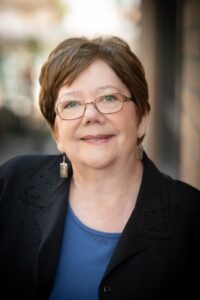Tragedies and statistics
Black Sunflowers
by Cynthia LeBrun
Toronto: Fitzhenry & Whiteside, 2024
$21.95 / 9781554556434
Reviewed by Ryan Frawley
*

Anyone who feels that we live in a dystopian hellscape would do well to study the history of the twentieth century. A period of conflict so brutal and suffering so perverse that some of its various genocides are in danger of being forgotten.
Cynthia LeBrun’s Black Sunflowers is called a novel, but it has its feet firmly planted in the pitch-black reality of the Holodomor, the Soviet-engineered famine that is estimated to have killed up to five million Ukrainians in the early 1930s. As Kelowna resident LeBrun points out in a note at the end of the book, the “events, people, and places described in this novel are, for the most part, based on my mother-in-law Veronika’s vivid memories of the times.”
It’s with Veronika’s viewpoint that the book begins. Children, with their keener experience of the details of the world around them, along with the inbuilt pathos of innocence, are often the most affecting witnesses to tragedy. When the story begins, Veronica is six years old.
Veronika’s parents are illiterate Ukrainian farmers of Polish descent who have already lost one son to famine, and who love their daughter with the fierceness that comes from loss. And yet, they are helpless victims, caught in the great movements of history with nothing to sustain them but their Catholic faith, their family, and their perseverance.
This perseverance is exemplified by Veronika’s father, Janek, and the story is told from his viewpoint too, in chapters that don’t rigidly alternate but instead switch back and forth between the two viewpoints according to the demands of the story being told. Janek, of course, is privilege to information that his daughter couldn’t know, and so we get a deeper insight into the full extent of the hardship he and his relatives face as the Soviet government tightens its grip on Ukraine.
In particular, following Janek’s viewpoint allows us to see the full horror of the famine in the cities. Veronika’s family are not insulated from the brutality of the regime—Veronika sees her uncles, aunts, cousin, and grandmother being taken away, with her uncles most likely executed immediately—but their farm and orchard, though seized by the state, allow them to produce enough food to just about get by.
In the cities, people are less fortunate. Janek, traveling with his brother to make some money selling knives, witnesses the appalling suffering of the starving, including villages ‘quarantined’ by the Soviets for failing to meet their grain quotas, with the result that people were forbidden to leave and simply left to die. Janek, goodhearted to a fault, is haunted by his efforts to help a starving child he finds and is forced to leave in the care of the state, only to learn she died shortly afterward.

Writing historical fiction carries an inherent obligation to the truth. It’s also necessary, especially when telling stories of a historic event that may not be common knowledge among your audience, to give the historical background that allows the story to resonate. Balancing the impulses of a historian with those of a novelist—the pedagogic impulse versus the aesthetic one—is key to the art of writing about the past, and LeBrun’s approach of telling the story through the eyes of a grown man and also of a growing girl is a worthy attempt to bridge that gap.
Perhaps it’s LeBrun’s former career as a teacher that leads her to sometimes stray a little too close to the classroom. That’s seen nowhere more clearly than in the quotes from historical sources that begin each chapter, explaining more about the Soviet government policies that made the famine so much worse. Useful historical background, certainly, but it does have a way of breaking the immersion in the story itself. (Lebrun includes a bibliography for anyone who wants to delve deeper into the topic.)
With that said, there are some nicely observed details that prevent Black Sunflowers from being a revved-up history lesson. We see Veronica licking the frost on the windows of the family’s humble cottage to see outside in the winter, the kind of detail that gives a novel reality. And her issues with the texture of food— her fastidious distaste for anything lumpy or slimy, including her grandmother’s stew—helps her to live in the mind as a fully-formed person rather than just a casualty of history.
“The death of one man is a tragedy. The death of millions is a statistic,” Josef Stalin is reported to have said. It’s in these moments of carefully observed humanity, these tiny details of daily life, that the full horror of history has its real impact. In Black Sunflowers, LeBrun doesn’t always manage to restrain herself from trying to teach us something. The prose has an unfortunate tendency to tell us about the internal lives of characters rather than letting us feel our way into them–“Veronika felt proud”; “To them, [the priest] was their king.” These are feelings that would be more effective if we were shown how they play out in real time rather than simply being told that they exist.
Black Sunflowers succeeds most when the characters are allowed the space to be real people. LeBrun is certainly capable of this, as in the memorable scene where Veronika does her homework, learning a poem about the glories of life under Stalin while her father carves a gravestone for a child for a little extra money.
By the time the novel closes, Veronika is a young woman, newly qualified as a teacher and looking to a bright future—a future that seems even brighter to the oppressed Ukrainians when they are liberated from Soviet rule by Nazi Germany. “They can’t be worse than the Soviets,” Veronica’s family believe. But of course, we know better. And as Veronika’s Jewish friend’s fate demonstrates, fresh horrors are coming.
To write about the past is to write about the present. As news from invaded Ukraine continues to fill headlines, this book feels timely in a way all good historical fiction should. And as the bloody twentieth century recedes away from us, it’s stories like this one that can put a human face on what would otherwise be a pile of grim statistics.

*

Ryan Frawley is a novelist and essayist whose short fiction has won numerous awards in BC and across Canada. He is the author of a novel, Scar, and a travel writing collection, Towers Temples Palaces: Essays from Europe. He also writes essays on medium.com and can be contacted at ryanfrawley.com. [Editor’s note: the above review is Ryan’s first for BCR. Welcome ahoy, Ryan!]
*
The British Columbia Review
Interim Editors, 2023-25: Trevor Marc Hughes (non-fiction), Brett Josef Grubisic (fiction and poetry)
Publisher: Richard Mackie
Formerly The Ormsby Review, The British Columbia Review is an online book review and journal service for BC writers and readers. The Advisory Board now consists of Jean Barman, Wade Davis, Robin Fisher, Barry Gough, Hugh Johnston, Kathy Mezei, Patricia Roy, and Graeme Wynn. Provincial Government Patron (since September 2018): Creative BC. Honorary Patron: Yosef Wosk. Scholarly Patron: SFU Graduate Liberal Studies. The British Columbia Review was founded in 2016 by Richard Mackie and Alan Twigg.
“Only connect.” – E.M. Forster